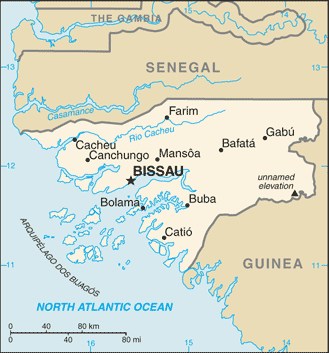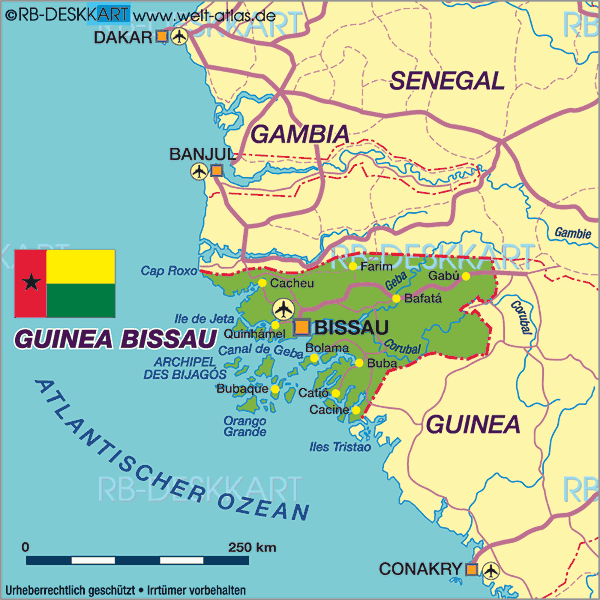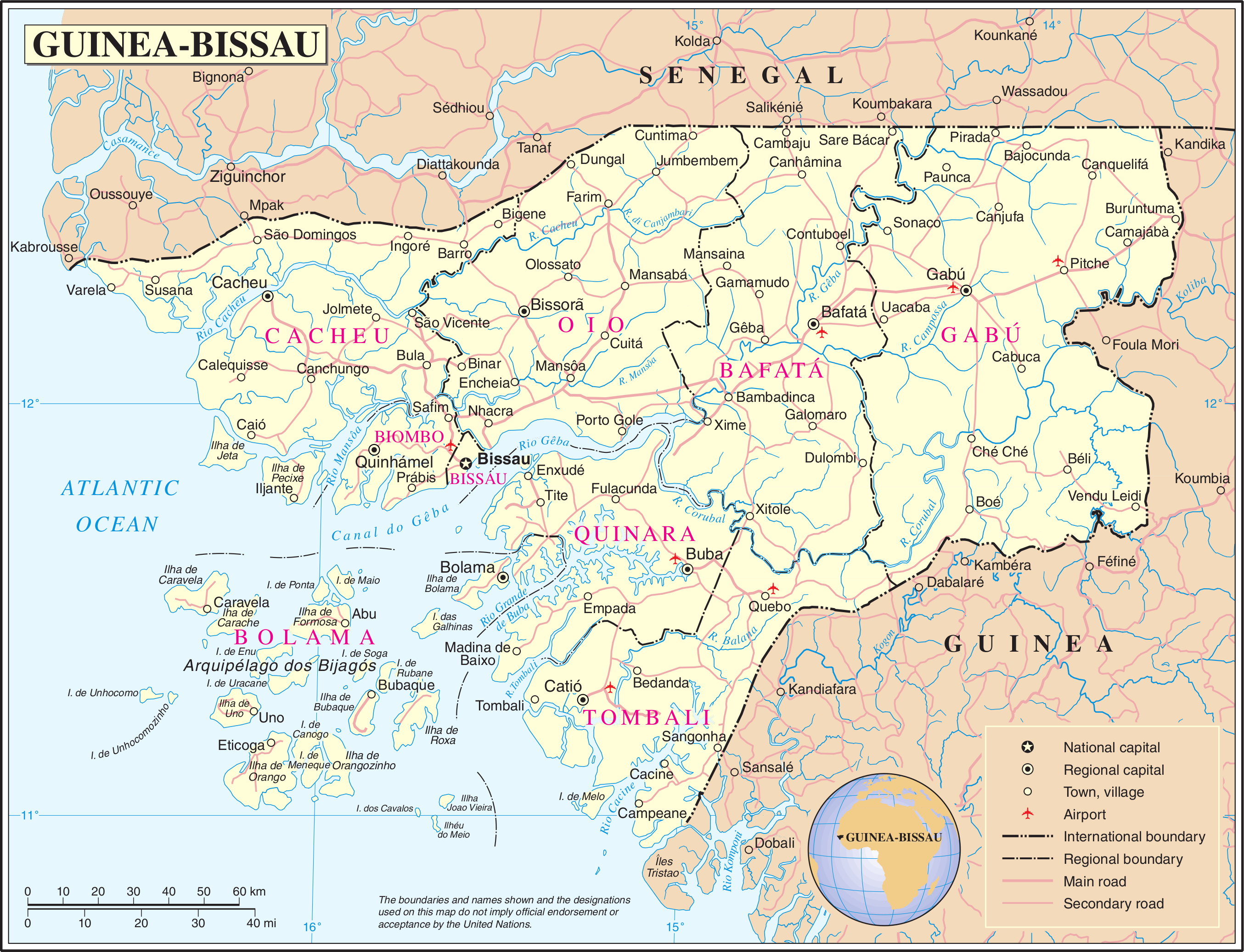Guinea-Bissau Map - Guinea-Bissau
The terrain of Guinea-Bissau is mostly low coastal
plain with swamps of Guinean mangroves rising to Guinean forest-savanna mosaic
in the east.[1]
The lowest point on Guinea-Bissau is at sea level at
the Atlantic Ocean.[1] The highest point on Guinea-Bissau is 300 metres above
sea level at an unnamed location in the northeast corner of the country.[1]
Guinea-Bissau Map - Guinea-Bissau Satellite Image - Physical
Natural resources found in Guinea-Bissau include fish, timber, phosphates, bauxite, clay, granite, limestone and unexploited deposits of petroleum.[1] 10.67% of the land is arable and 235.6 square kilometres is irrigated.[1]
Natural hazards include a hot, dry, dusty harmattan haze that may reduce visibility during the dry season and brush fires.[1] Severe environmental issues include deforestation; soil erosion; overgrazing and overfishing.[1]
Near the Senegal border there have been historic sightings of the painted hunting dog, Lycaon pictus, but that endangered canid may now be extirpated in that locale.[2]
Political Map of Guinea Bissau - Nations
Guinea-Bissau was once part of the kingdom of Gabu,
part of the Mali Empire; parts of this kingdom persisted until the 18th
century. Other parts of the territory in the current country were considered by
the Portuguese as part of their empire.[5] Portuguese Guinea was known as the
Slave Coast, as it was a major area for the exportation of African slaves by
Europeans to the western hemisphere. Previously slaves had been traded by Arabs
north to the northern part of Africa and into the Middle East.
Early reports of Europeans reaching this area include
those of the Venetian Alvise Cadamosto's voyage of 1455,[6] the 1479–1480
voyage by Flemish-French trader Eustache de la Fosse,[7] and Diogo Cão. In the
1480s this Portuguese explorer reached the Congo River and the lands of
Bakongo, setting up the foundations of modern Angola, some 4200 km down the
African coast from Guinea-Bissau.[8]
Guinea-Bissau Atlas: Maps and Online Resources
Although the rivers and coast of this area were among the first places colonized by the Portuguese, who set up trading posts in the 16th century, they did not explore the interior until the 19th century. The local African rulers in Guinea, some of whom prospered greatly from the slave trade, controlled the inland trade and did not allow the Europeans into the interior. They kept them in the fortified coastal settlements where the trading took place.[9] African communities that fought back against slave traders also distrusted European adventurers and would-be settlers. The Portuguese in Guinea were largely restricted to the port of Bissau and Cacheu. A small number of European settlers established isolated farms along Bissau's inland rivers.[9]
Road Map of Guinea Bissau
For a brief period in the 1790s, the British tried to establish a rival foothold on an offshore island, at Bolama.[10] But by the 19th century the Portuguese were sufficiently secure in Bissau to regard the neighbouring coastline as their own special territory, also up north in part of present South Senegal.
Guinea-Bissau Map / Geography of Guinea-Bissau
An armed rebellion beginning in 1956 by the African Party for the Independence of Guinea and Cape Verde (PAIGC) under the leadership of Amílcar Cabral gradually consolidated its hold on then Portuguese Guinea.[11] Unlike guerrilla movements in other Portuguese colonies, the PAIGC rapidly extended its military control over large portions of the territory, aided by the jungle-like terrain, its easily reached borderlines with neighbouring allies, and large quantities of arms from Cuba, China, the Soviet Union, and left-leaning African countries.[12] Cuba also agreed to supply artillery experts, doctors, and technicians.[13] The PAIGC even managed to acquire a significant anti-aircraft capability in order to defend itself against aerial attack. By 1973, the PAIGC was in control of many parts of Guinea, although the movement suffered a setback in January 1973 when Cabral was assassinated.[14]
Physical Map of Guinea Bissau
Independence was unilaterally declared on 24 September
1973. Recognition became universal following the 25 April 1974
socialist-inspired military coup in Portugal, which overthrew Lisbon's Estado
Novo regime.[15]
Administrative Map of Guinea-Bissau
Luís Cabral, brother of Amílcar and co-founder of PAIGC, was appointed the first President of Guinea-Bissau. Following independence, the PAIGC killed thousands of local Guinean soldiers who had fought along with the Portuguese Army against guerrillas. Some escaped to settle in Portugal or other African nations.[16] One of the massacres occurred in the town of Bissorã. In 1980 the PAIGC acknowledged in its newspaper Nó Pintcha (dated 29 November 1980) that many Gueinean soldiers had been executed and buried in unmarked collective graves in the woods of Cumerá, Portogole, and Mansabá.
Guinea Bissau Political Map
The country was controlled by a revolutionary council until 1984. The first multi-party elections were held in 1994. An army uprising in May 1998 led to the Guinea-Bissau Civil War and the president's ousting in June 1999.[17] Elections were held again in 2000, and Kumba Ialá was elected president.[18]
Guinea-Bissau Map / Geography of Guinea-Bissau
In September 2003, a military coup was conducted. The military arrested Ialá on the charge of being "unable to solve the problems".[19] After being delayed several times, legislative elections were held in March 2004. A mutiny of military factions in October 2004 resulted in the death of the head of the armed forces and caused widespread unrest.
Guinea Bissau Maps - Perry
In September 2003, a military coup was conducted. The military arrested Ialá on the charge of being "unable to solve the problems".[19] After being delayed several times, legislative elections were held in March 2004. A mutiny of military factions in October 2004 resulted in the death of the head of the armed forces and caused widespread unrest.
Guinea Bissau Political Map | Political Map of Guinea Bissau
Guinea-Bissau is a republic. In the past, the
government had been highly centralized. Multi-party governance was not
established until mid-1991. The president is the head of state and the prime
minister is the head of government. Since 1974, no president has successfully
served a full five-year term.[28]
Guinea-Bissau
At the legislative level, a unicameral Assembleia Nacional Popular (National People's Assembly) is made up of 100 members. They are popularly elected from multi-member constituencies to serve a four-year term. The judicial system is headed by a Tribunal Supremo da Justiça (Supreme Court), made up of nine justices appointed by the president; they serve at the pleasure of the president.[29]
Map of Guinea-Bissau
Guinea-Bissau is bordered by Senegal to the north and
Guinea to the south and east, with the Atlantic Ocean to its west. It lies
mostly between latitudes 11° and 13°N (a small area is south of 11°), and
longitudes 13° and 17°W.
At 36,125 square kilometres (13,948 sq mi), the
country is larger in size than Taiwan or Belgium. It lies at a low altitude;
its highest point is 300 metres (984 ft). The terrain of is mostly low coastal
plain with swamps of Guinean mangroves rising to Guinean forest-savanna mosaic
in the east.[34] Its monsoon-like rainy season alternates with periods of hot,
dry harmattan winds blowing from the Sahara. The Bijagos Archipelago lies off
of the mainland.[35]
Guinea Bissau Cities Map, Major Cities in Guinea Bissau
The population of Guinea-Bissau is ethnically diverse
and has many distinct languages, customs, and social structures.
Guinea-Bissauans can be divided into the following
ethnic groups:
Fula and the Mandinka-speaking people, who comprise
the largest portion of the population and are concentrated in the north and
northeast;
Balanta and Papel people, who live in the southern
coastal regions; and
Manjaco and Mancanha, who occupy the central and
northern coastal areas.
Most of the remainder are mestiços of mixed Portuguese
and African descent, including a Cape Verdean minority.[45]
Map of Guinea Bissau - Map in the Atlas of the World - World
Portuguese natives comprise a very small percentage of Guinea-Bissauans. After Guinea-Bissau gained independence, most of the Portuguese nationals left the country. The country has a tiny Chinese population.[46] These include traders and merchants of mixed Portuguese and Chinese ancestry from Macau, a former Asian Portuguese colony.
Guinea-Bissau Guide
14% of the population speaks
the official language Portuguese,
the language of government and national communication during centuries of
colonial rule. 44% speak Kriol, aPortuguese-based
creole language, which is effectively a national language of
communication among groups. The remainder speak a variety of native African
languages unique to ethnicities.[47]
Most
Portuguese and Mestiços speak one of the African languages and Kriol as second
languages. French is also taught in schools because Guinea-Bissau is surrounded
by French-speaking nations. Guinea-Bissau is a full member of the Francophonie.[48]
Guinea-Bissau Map - Guinea-Bissau
14% of the population speaks the official language Portuguese, the language of government and national communication during centuries of colonial rule. 44% speak Kriol, a Portuguese-based creole language, which is effectively a national language of communication among groups. The remainder speak a variety of native African languages unique to ethnicities.[47]
Most Portuguese and Mestiços speak one of the African languages and Kriol as second languages. French is also taught in schools because Guinea-Bissau is surrounded by French-speaking nations. Guinea-Bissau is a full member of the Francophonie.[48]



Hiç yorum yok:
Yorum Gönder